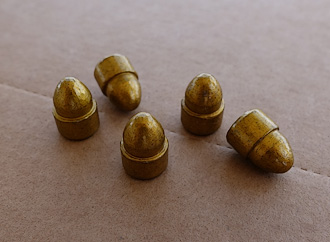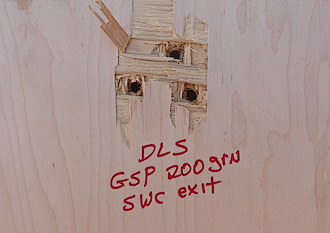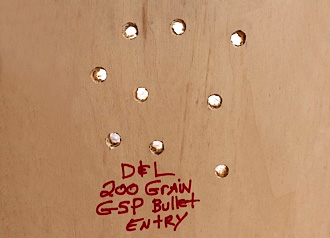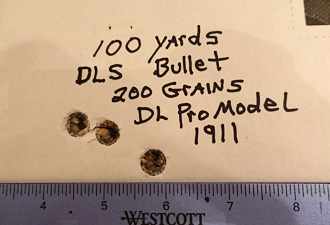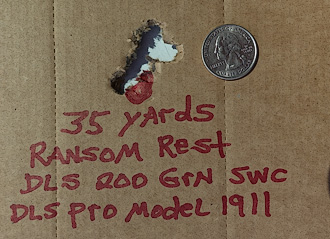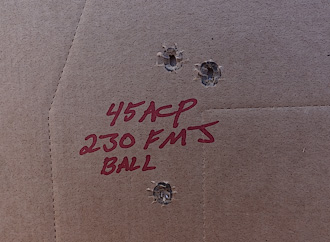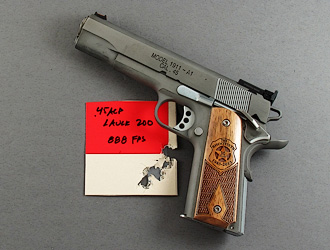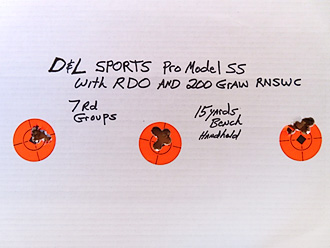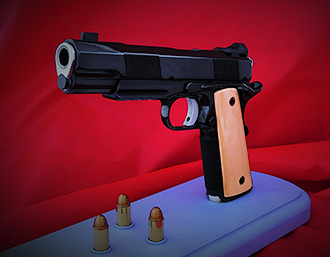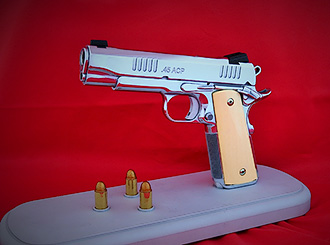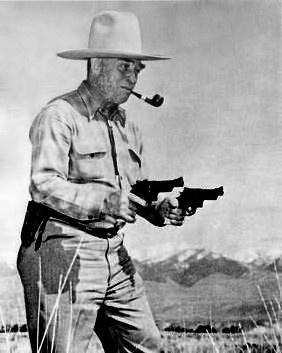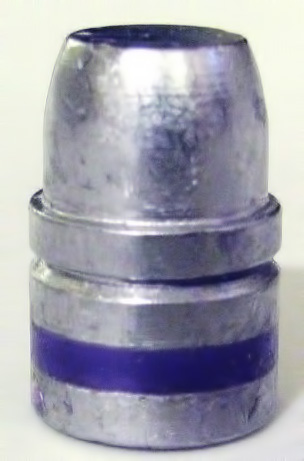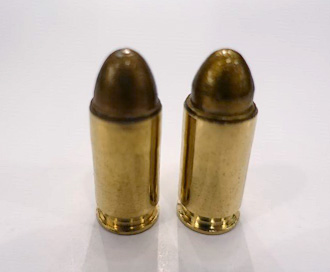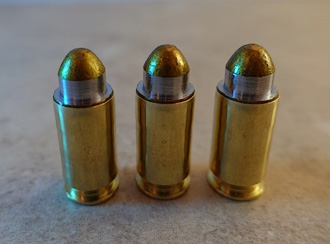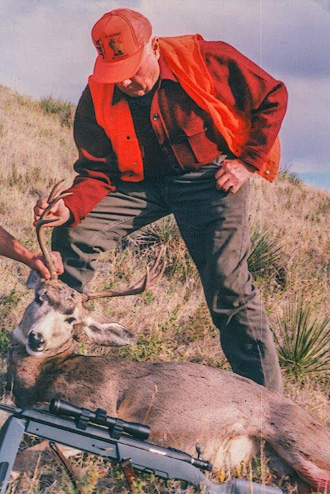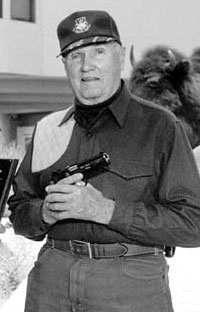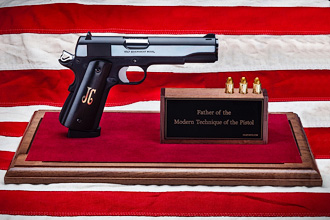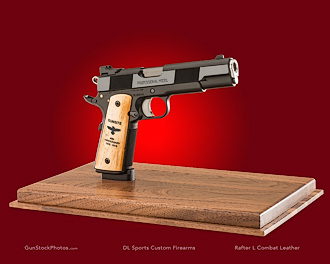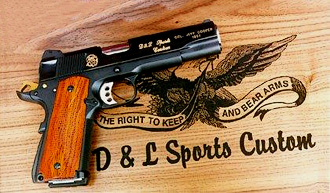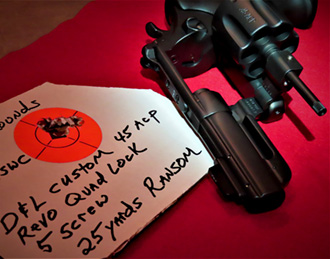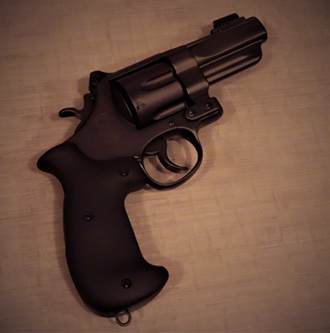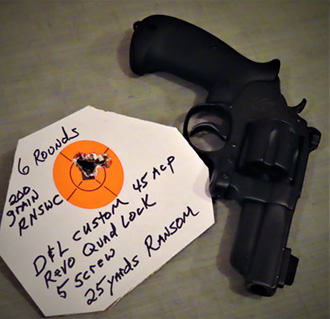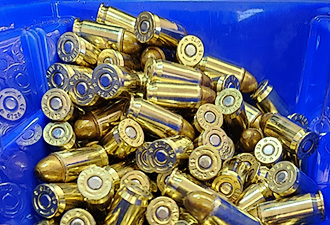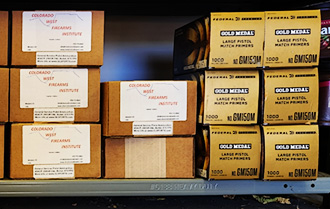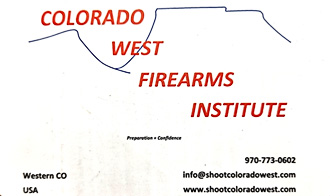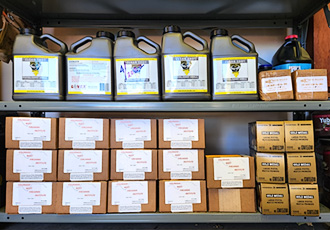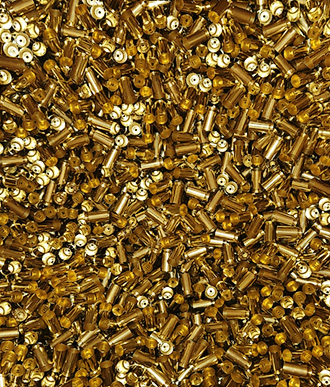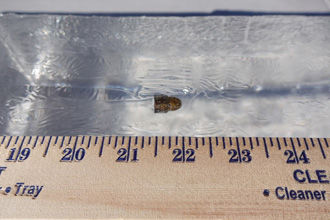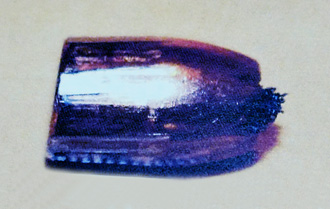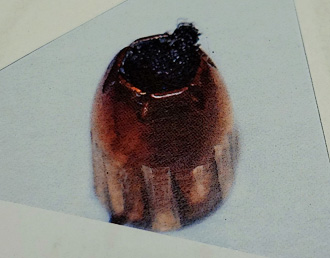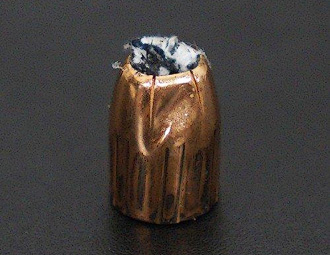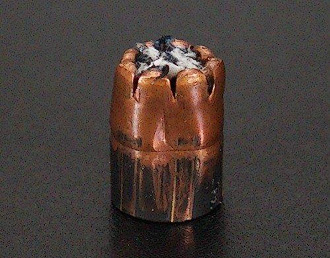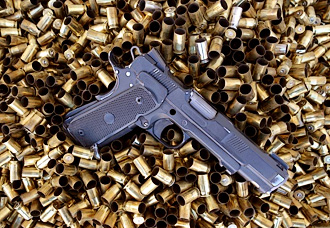|
D&L .45 ACP Bullet and Ammunition
|
||||||||||||
These bullets are available with two shoulder types, one for revolvers and one for autopistols. |
||||||||||||
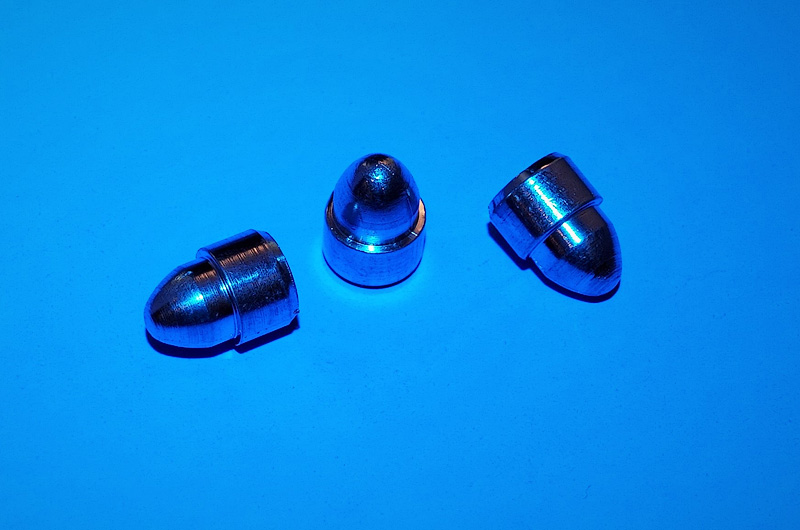 |
||||||||||||
|
Historical development of the D&L .45 ACP Bullet The mid and late nineteenth century firmly established the .45 caliber pistol as reasonably effective in the civil war with .45 caliber ball, and then into the western frontier with metallic cartridges, .45 caliber bullets, and the 1873 Colt Peacemaker. Lessons from decades of real life ballistic experience were not being heeded when the US Army issued .38 caliber S&W revolvers for U.S. troops serving in the Philippines. A local muslim tribe, the Moros, rebelled and the army participated in suppression of that rebellion. However U.S. troops found the smaller caliber .38 inadequate for stopping motivated tribesmen. Instances were reported where tribesmen had been shot through and through several times with a .38 caliber revolver yet still managed to cut up the unfortunate individual armed with the .38. (reported in 1908) In the next decade the army adopted the 1911 45 ACP. We know from study and experience that aggressors can be hit with nearly any pistol load and still fail to stop. However, history indicates that a hit from a larger, more powerful handgun is more likely to stop an aggressor than a hit from a lessor cartridge. Modern attempts to 'prove' smaller cartridges are just as effective, or more effective than larger cartridges through gelatin testing does not square with history, or with dispatching live game animals in the 100 – 400 pound category with torso pistol shots. An opinion that is accurate, and a real reason for adoption of small caliber handguns is that it is easier to train novice shooters to qualify with smaller cartridges. We are seeing this failure to properly train first responders to a reasonable skill level much too often in our modern times. This lack of training and skill is repeatedly demonstrated in high volume shootings with very poor hit rates. Pioneers in shooting history have provided us with much information and experience from which to draw, and expand upon, by continuing the quest for improved performance. One of these shooting pioneers was Elmer Keith (1899 -1984). Mr. Keith is probably best known for his efforts in developing 'magnum' revolvers. He is also known for his efforts in improving pistol bullet designs. His work in the area of bullet design led to the creation of "Keith Style" bullets. The final bullet designs were primarily flat nose semiwadcutters. SWC bullets feature full caliber cutting shoulders to cut relatively clean holes, while the reduced caliber nose achieves a higher ballistic coefficient than a full wadcutter bullet. A well-made SWC bullet works well for both target shooting and hunting (when used within the limitations of a handgun). Experienced hunters who have used hollowpoint and softpoint bullets at conventional handgun velocities have witnessed their failures and inconsistencies first hand. Mr. Keith, and other experienced handgun hunters have concluded that a large caliber solid bullet, with a full caliber cutting shoulder works best. It is very difficult to objectively argue with actual successful performance in the field. You can read more about Mr. Keith's experience and development in his books, including "Sixguns", published in 1955. "A large entrance hole is just as important as a large exit hole… placing the first shot is of vital importance… if the bullet be properly shaped it will cut a full caliber hole which is what you want… we found this out the hard way… back in 1917." - Elmer Keith. Mr. Keith's opinions were also confirmed during the Thompson-LaGarde tests of 1904: of the rounds tested, .45 caliber or larger projectiles were found to be most effective. They also noted that training was critical to make sure shooters could make hits in the vitals for handgun bullets to be effective. In other words, they recognized shot placement with pistol bullets is critical, and proper training was required to achieve proper hits. (Now in modern times we find the hit rate achieved by emergency responders to be very poor. Instead of increasing professional training, people have sought to address the problem with higher magazine capacity. We now see the results of this mentality with high numbers of rounds being fired during serious incidents and dismally low hit rates being achieved.) The 1911 autopistol was available in Mr. Keith's lifetime, but was not as developed and refined as it has become in more modern times. In some cases, modernization of the 1911 was a detriment to its reliability. Other developments for the 1911 have truly advanced it to a new level of performance.
John Dean Cooper, aka "Jeff" Cooper and Colonel Cooper (1920-2006), is the person who really educated people about the "shootability" of the 1911 pistol. John Moses Browning (1855-1926) is deservedly considered the genius of modern firearms design, and was the designer of the 1911 pistol. The overall layout of the 1911 pistol design is 'just right' for the human hand. It was Col. Cooper who most brought this information to the attention of the international shooting community. Col. Cooper's experience in WWII and the Korean war formed his opinion that large bore handguns were best for close combat, and the 1911 pistol provided a superior design layout and a .45 caliber projectile capability. Col. Cooper developed a "Modern Technique" for using a pistol in defensive encounters, and founded the American Pistol Institute/Gunsite in 1976. Gunsite is a place where people can learn gun safety, mindset, awareness and the techniques Col Cooper developed. (Training at 'Gunsite' in Paulden, AZ still continues today thanks to Buz Mills. You can learn more, obtain books by Col. Cooper, and sign up for courses by going to www.Gunsite.com). Col. Cooper and Dave Lauck came together over mutual interests improving performance in shooting, training, hunting, bullets and firearms. Col. Cooper often used the G.I. loading for the 1911 pistol; 230 grain FMJ ball ammo. However, he was aware that the "Keith" bullet design offered improved wounding effect at handgun velocities. The drawback was that the flat/sharp nose of the Keith bullet was not the proper design to work well in the 1911 autopistol which was designed for FMJ ball bullets. Both Col. Cooper and Lauck agreed that anything that was adverse to pistol reliability was unacceptable. Col. Cooper moved his experimentation forward by testing FMJ truncated cone flat point bullets. The bullet only featured a small caliber flat point and it was rounded and radiused to help feeding reliability. Testing revealed that the bullet suffered from bullet set back during the feeding cycle, as neither the bullet or the case were cannelured. The rounded small flat on the nose, and lack of full caliber cutting shoulder made its 'improvement' over ball bullets questionable. The bullet push back issue adversely affected reliability, so that made it a no-go for serious carry ammunition. During a 1997 big game hunting trip Col. Cooper and Lauck discussed creating something better as an all-around load and bullet for the .45 ACP 1911 pistol. Both Col. Cooper and Lauck recognized the issues of concern with ball ammo in tissue; bullet 'push through'. They also recognized inconsistent performance and failures with HP and SP bullets when fired at .45 ACP velocities. Turning up the velocity for better performance could be mechanically dangerous, and disrupt the excellent balance of speed, power, and accuracy that the .45 ACP provides. A full caliber cutting shoulder on a 200 grain .45 ACP bullet at a reasonable 850 – 900 FPS velocity would be a logical solution. (History tells us that Mr. Browning initially developed a 200 grain .45 ACP loading at 900 FPS for the Model 1905 before it morphed into the 1911 pistol. It was reportedly the U.S. military who requested the bullet weight be increased to 230 grains to be closer to the .45 Colt load that the cavalry was using. Mr. Browning's contributions to arms development has proven to be so significant that his thoughts cannot be overlooked.) Col. Cooper and Lauck knew there was a noticeable improvement in .45 ACP impact performance when using 200 grain H&G68 bullets at 850-900 FPS during hunting and for dispatching wounded game. H&G68 bullets are also widely used by competition shooters due to their clean hole cutting ability in paper targets. However, the H&G68 bullet features a flat point, in addition to a full caliber cutting shoulder. The flat point will often cause a stumble during the feed cycle of a 1911. Many guns will feed the bullet, but a knowledgeable 1911 mechanic can feel the stumble. A stumble is too close to a failure to feed for the bullet to be used as an all-around carry round. A good feature of the narrowed nose of the H&G68 bullet was that it would bypass the internal lug of the slide stop on a 1911 pistol, thus not causing slide lock back while the pistol was still loaded, a problem that round nose ball bullets can cause. Following the 1997 hunting trip the Cooper and Lauck families traveled to the Buffalo Bill Historical Center/Museum in Cody, Wyoming where Col. Cooper's custom 1911 pistol was inducted into the museum for display, along with recognition of Col. Cooper's contributions to the firearms world. Col. Cooper's comments about bullets were consistent with observed field performance. "I do not have use for JHP/SP bullets in handguns. At typical handgun velocities bullet expansion is inconsistent at best, and sometimes completely non-existent. Sometimes the penetration of JHP/SP bullets is very limited, and so is the effect of the wound. Worse is the functional unreliability that they can cause. Shooting into gelatin is not the same as living tissue because there are more things involved than just consistent physical resistance. Bones also have to be considered. The semi wadcutter is a very good bullet shape. If you take a .45 ACP and load it with a SWC bullet you are going to take a radical jump in stopping power. In my personal view, what causes the increase in stopping power is the 'cookie cutter' effect. When SWC bullets are driving through tissue they are not bending muscle and nerve tissue out of the way, they are chopping it like a cookie cutter. We see this effect in the wounding when using a sharp shoulder on the bullet. A cookie cutter bullet plows its way through, chops its way through. It is a very good wounding effect." - Col. Jeff Cooper The goal was clear. Create a 200 grain SWC bullet specifically for the 1911 autopistol. Now approaching the 100th birthday of Col. Cooper, it has been achieved. Lauck's mechanical design knowledge of the 1911 pistol allowed for profiling a rounded bullet nose to best conform with the two stage feed ramp of the pistol and feed with a smoothness not achieved before. The narrowed rounded nose of the new D&L 200 grain bullet feeds BETTER than 230 grain FMJ ball bullets. The narrowed bullet nose no longer has the bluntness of ball bullets which can false lock the pistol open while it is still loaded. The narrowed nose also improves ballistic coefficient. Now centermass holding is possible from 0 – 50 yards. During 2017-2018 over 100,000 rounds of the prototype bullets were tested in a single 1911 pro model with compatible magazines. Zero stoppages. If your 1911 pistol and magazine combination will not feed these properly loaded bullets, your pistol needs adjustment. This load has also been tested in a variety of other .45 ACP pistols and demonstrated the same smooth feeding performance. The Brinell hardness of the D&L 200 grain RNSWC bullet is 17. Why? The hardness of the bullet interacts with the pressure generated by the cartridge/load being used. Selecting the proper bullet hardness for the pressure generated by the .45 ACP load being used causes the bullet to properly obturate and seal the bore. In other words, history, experience, and a mathematical formula concludes that 17 is the proper Brinell hardness for this .45 ACP loading. This, combined with the fully coated bullet, makes barrel leading a thing of the past. The coating on these bullets is known as Hi-Tek Supercoat. It is a unique heat-set coating originally developed in Australia. Lauck designed the bullet molds to form this new 200 grain .45 ACP bullet to not only create a new bullet shape, but also to use with this coating process. The coating dramatically reduces smoke compared to conventional lead bullets. Lead fouling of the bore is drastically reduced, or in most cases eliminated completely. Even after high round count training sessions, bore cleaning is simplistic. With this coating there is no need for wax lube which commonly gums up loading dies and guns alike. The end result is cleaner air, hands, guns, and loading equipment. The narrowed base of the round nose of the D&L bullet also allows for the formation of a full caliber cutting shoulder on the bullet. Now we have the .452" hole cutting ability of the HG68 bullet, with superior feeding reliability. This is combined with a beveled bullet base for smooth seating, and a full coverage coating to solve the problems of smoke and barrel leading. We are now at a time in development history where we have a bullet well suited for all-around .45 ACP ammunition, GSP (General Service Pistol) ammunition. There is no longer a need to switch out ammunition between practice and 'duty' ammunition, there are no longer the problems of different recoil impulses and different zero points, there is no need for supersonic defensive pistol ammo with the increased noise and blast it produces. Using high pressure, or Plus P, ammunition in an effort to force hollow point bullets to perform better not only increases blast and noise, it also operates close to the level of rupturing cartridge cases. When you operate at this level of pressure, have non-supported case web, combined with a dirty or partially obstructed bore, a blown case can become reality. Once this happens you may lose your sight, be injured by your own equipment, and your pistol will probably become non-functional. It is not necessary to operate at this level… This 200 grain .45 ACP load is controllable and has an excellent balance of speed, power, and accuracy. One load all the time. This is not a magic bullet, nor an overated wonder bullet. The D&L bullet is simply a .45 caliber 200 grain SWC coated lead projectile that shoots accurately and functions well. You must place it properly for it to be effective. Just remember your safety rules, and that shot placement is most important with any pistol bullet. For defensive handgun shooters, avoid the confrontation whenever it is realistic to do so. When you can't avoid the conflict, consider this… There are generally four ways to 'stop' a dangerous threat with a handgun; Bullet penetration and serious damage to the brain/upper spinal cord. Damage to the skeletal system. Major blood loss. Mental surrender (aggressor gives up the fight). Any bullet style/caliber that does sufficient damage to the brain and or upper spinal cord is probably going to end the situation, so caliber arguments are moot. However, the head can be a small, difficult to hit moving target, and bullets may deflect and or not penetrate a vital area. If mental surrender is achieved, the situation is also solved. Mental surrender is unpredictable. Body impacts are the most likely because the body is the largest target area. This is where the large caliber, deep penetrating pistol bullet has probable advantage over light caliber, low penetration bullets. Skeletal damage and quicker blood loss are more likely with larger pistol bullets. However, body shots with any caliber often take time to take effect. Be prepared to deal with continued aggression and for follow up shots. Become a safe and skilled handgunner and make the choices that best suit your requirements. |
||||||||||||
The latest version of the Redding reloading manual now recognizes the .45 ACP round nose wadcutter as the "Best Feeding" 45 ACP bullet available. |
||||||||||||
|
Using ballistic gel to test and evaluate bullet performance has become commonplace. Some people swear by it, and other people swear about it. It is not a perfect medium, but it does allow some comparisons to take place. After decades of observations related to bullet performance in real life, and seeing how those bullets perform in gel testing, we had a target goal of 20 inches of gel penetration for a general purpose 45 ACP loading. There are of course scenarios where more or less penetration may be preferred, but most times you do not get to choose the exact circumstances that will confront you. Military 230 ball ammo commonly exceeds 32 inches in gel penetration. In certain circumstances, such as cold weather environments, heavy clothing, fat, muscle, bone, barriers and fur, the extra penetration may work well. For an all-around general carry load more moderate penetration of about 20 inches was sought. By driving the DLS 200 grain shouldered bullet at 875 FPS 22 inches of bare ballistic gel penetration was achieved. Firing the same load through four layers of denim material over the face of the gel block resulted in 19 inches of gel penetration. |
||||||||||||
| The above modern JHP bullets were all recovered after close range, unarmored shootings. They were all fired from full power factory loaded cartridges. Expansion is almost non-existent. This is a common problem when JHP bullets are fired at 45 acp velocities. In these situations the JHP bullets typically perform like FMJ ammo, and add the risk of failure to feed due to the blunt nose with sharp edges. The DLS Inc bullet design does not need to rely on expansion to achieve full caliber cutting action, and feeds through the pistol with superior reliability. | ||||||||||||
| Two modern .45 ACP JHP bullets fired out of full power factory loaded ammunition. Distance was 10 feet, through common clothing, and into 10% ballistic gelatin. Failure to perform as advertised. | ||||||||||||
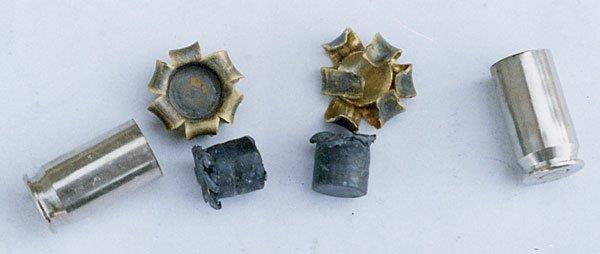 |
||||||||||||
| Another common problem with jacketed pistol bullets is jacket/core separation, resulting failure to properly penetrate. | ||||||||||||
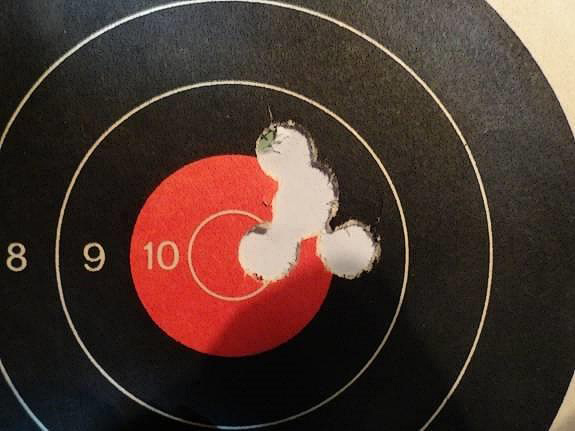 Full caliber holes cut by the DLS bullet |
||||||||||||
The D&L bullet has been extensively tested for functional reliability in the 1911 and other autopistols. You should do the same before adopting this or any other bullet. |
||||||||||||
|
||||||||||||
| Paladin Press created a video series called "Jeff Cooper's Defensive Pistolcraft Tape Series". In this 4 volume set Col. Cooper discusses his thoughts on cartridges, bullets, and loads. |
||||||||||||
| Basic Gun Safety Rules All guns are always loaded. Never allow the muzzle to cross anything you are not willing to destroy. Keep your finger off the trigger until your sights are on the target and you are prepared to fire. Be sure of your target and what is beyond. (Be mindful of over penetration and ricochets.) |
||||||||||||
| Ammunition intended for serious purposes should be thoroughly inspected prior to carry, no matter who the manufacturer is. These checks should include individual cartridge visual inspections, cartridge case gauging each cartridge to assure proper overall specs, visual primer inspection, and weighing each individual cartridge to assure they equal the total combined weight of bullet, correct powder charge, and primed case. | ||||||||||||
| Professional ammunition manufacturers who load for autopistols are well served by using Lee Precision's U die (undersized Die). This .45 ACP carbide sizing die sizes cases .002-.003" tighter than standard in order to secure the bullet against bullet push back during the feed cycle. Be sure to bell the case mouth for smooth bullet seating, and then do a proper taper crimp of .465" case mouth O.D. for smooth feeding. 1.260" - 1.265", depending on the specs of your handgun, is the correct O.A.L. for the cartridge with the 200 grain bullet seated in place. Each handgun must be individually tested for functional reliability by the owner/operator. Do not repeatedly chamber individual cartridges or damage and unreliability may result. Use fresh, dry, clean, oil free ammunition. | ||||||||||||
| All bullet/ammo orders should be directed to: Mitch Thomas Colorado West Shooting Team 970 773 0602 www.shootcoloradowest.com mt5000us@gmail.com |
||||||||||||
| ||||||||||||
| ||||||||||||
| ||||||||||||
|
||||||||||||
|
||||||||||||
|
||||||||||||
|
||||||||||||
|
||||||||||||
Bullet performance update
|
||||||||||||
|
||||||||||||
|
||||||||||||
|
||||||||||||
D&L Sports All Purpose 45ACP Ammunition and Ballistics Gel Test |
||||||||||||
| In 2020 this ammunition was tested by a USPSA reloading expert. He got remarkably close results from two different test barrels, with an excellent 4.8 standard deviation. The ammunition easily make major power factor. The new bullet design gave no hiccups, it fed fine and both test guns. | ||||||||||||
45ACP D&L Ammo Testing: Practice and Carry Ammo All In One |
||||||||||||
| ||||||||||||
| ||||||||||||
| ||||||||||||
|
||||||||||||
| ||||||||||||
